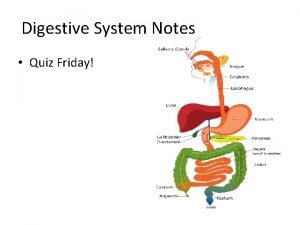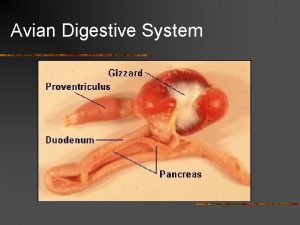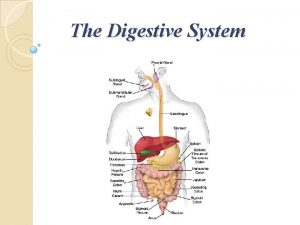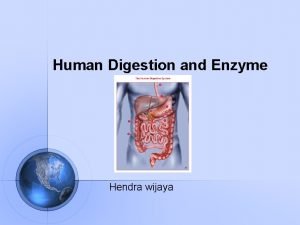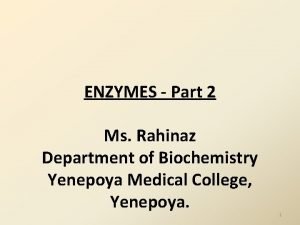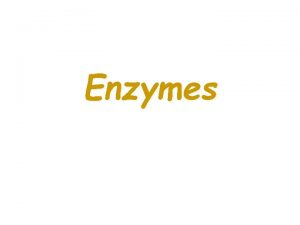The Digestive System Functions of the Digestive System










- Slides: 10

The Digestive System

Functions of the Digestive System 1. Extracts nutrients through chemical & mechanical digestion 2. Absorbs nutrients from food 3. Removes undigested wastes 4. Maintains water and chemical balances

Path of Food Through the Digestive System Mouth (includes salivary gland, teeth and tongue) Esophagus (tube connecting mouth to stomach) Stomach (contains hydrochloric acid) Small Intestine (longest structure – absorbs nutrients) Large intestine (colon) (water absorption) Rectum (storage of non-digested waste) Anus (removal of non-digested waste)

Accessory Organs (Help with digestion, but food does not pass through them) Pancreas – produces digestive enzymes which break down carbohydrates, proteins and fat Liver – produces bile which helps break down fat Gall Bladder – bile is stored in this organ Spleen – helps transport and transform nutrients Appendix – contains massive amounts of bacteria which aid in digestion Salivary Glands – produces saliva which breaks down starch into sugars

Digestive Enzymes (don’t need to memorize. . just informative) Saliva Amylase – breaks down starch Stomach Pepsin – breaks down proteins Pancreas Amylase Trypsin – breaks down proteins into peptides Lipase – breaks down fats (lipids) Nuclease – breaks down nucleic acids into nucleotides Small Intestine Maltase – breaks down maltose into glucose Sucrase – breaks down sucrose into glucose Peptidase – breaks down peptides into amino acids Nuclease – breaks down nucleotides into sugar and nitrogen bases

The villi line the small intestine. They are microscopic, finger-like projections. They increase the surface area of the small intestine allowing for more absorption of nutrients Sugars and amino acids enter capillaries and fatty acids enter the lymphatic vessels inside the villi. Role of Villi

What is peristalsis? The wave-like contractions of smooth muscle in the digestive tract which propels food through the esophagus, stomach, small and large intestines, and rectum.

Diseases of the Digestive System Appendicitis - A blockage inside of the appendix causes appendicitis. The blockage leads to increased pressure, problems with blood flow and inflammation. If the blockage is not treated, the appendix can break open and leak infection into the body.

Diverticulosis and Diverticulitis - diverticula are small pouches that bulge outward through the colon, or Large intestine. If you have these pouches, you have diverticulosis. It the pouches become infected or inflame you have diverticulitis. The maincause is a diet low in fiber.

Peptic Ulcer - a peptic ulcer is a sore in the lining of your stomach or your duodenum, the first part of our small intestine. A burning stomach pain is the most common symptom.
 The food path
The food path Main functions of the digestive system
Main functions of the digestive system Avian digestive system
Avian digestive system Conclusion of digestive system
Conclusion of digestive system H pylori symptoms
H pylori symptoms Respiratory system circulatory system digestive system
Respiratory system circulatory system digestive system Enzyme secreted by small intestine
Enzyme secreted by small intestine List of enzymes and their functions
List of enzymes and their functions Examples of enzymes
Examples of enzymes Nervous system and digestive system
Nervous system and digestive system Piecewise functions absolute value
Piecewise functions absolute value
